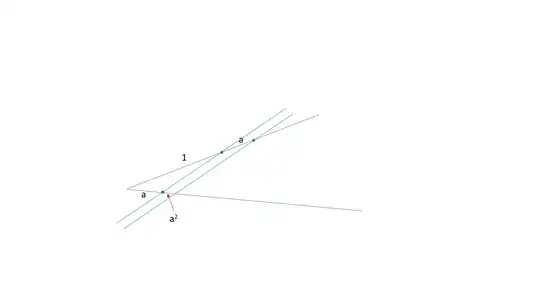The length of a segment is given. How can we construct a segment equal to the square of the given segment?
Asked
Active
Viewed 82 times
1
-
1Hint: Use a Thales Theorem – May 13 '18 at 16:36
-
Okey, but how do I construct a^2 if I have been given the length of "a". – Maxim Kasnedelchev May 13 '18 at 16:43
-
Do you mean constructing with the given straight segment and a compass? – DonAntonio May 13 '18 at 16:44
-
Yes I should construct it with a compass and a straight segment. – Maxim Kasnedelchev May 13 '18 at 16:48
3 Answers
4
Use this construction. BTW, it can also be used to multiply $a$ times $b$:
The green lines are parallel. The blue lines are any two that form an angle. You need a unit length as well, of course.
John Hughes
- 93,729
-
-
1But then this construction requires two line segments: one of length $;a;$ , the other one of length $;1;$ ... – DonAntonio May 13 '18 at 17:22
-
-
-
Also: see silverfish's comment on the question here (https://math.stackexchange.com/questions/705/compass-and-straightedge-construction-of-the-square-root-of-a-given-line) to see why a unit length is necessary for the question even to make sense. (Also Isaac's answer to the same question.) – John Hughes May 13 '18 at 19:23
0
Carry out the inversion of the point $1$ on the $x$-axis with respect to the circle of radius $a$ centered at the origin.
Mikhail Katz
- 42,112
- 3
- 66
- 131
0
Revised attempt:
1) Construct a $\triangle DBC$ with :
$|DB|=1;$ $ \angle BDC =90°$; $|DC|=a$ .
2) Construct a right angle at $C$, with one leg $BC$.
The other leg of this angle intersects $BD$
at $A$, I.e $\angle BCA =90°$.
3) We have :
$|AD| \cdot 1 = a^2.$
Peter Szilas
- 20,344
- 2
- 17
- 28
-
-
-
Looks good! Note that your solution (like mine) requires that you have a unit length as well as the length $a$ (see DonAntonio's comment on my answer). – John Hughes May 13 '18 at 22:13
-
-
-
Maxim.John Hughes' and Don Antonio's comment, you need a length a, and a unit length.My answer: Under 1) :construction of triangle DBC we use Side, Angle,Side with lengths a,1, and angle 90°.ok? – Peter Szilas May 14 '18 at 18:20
